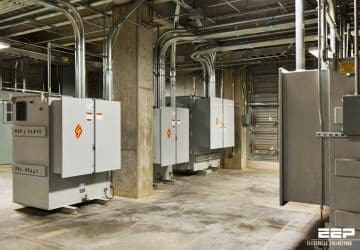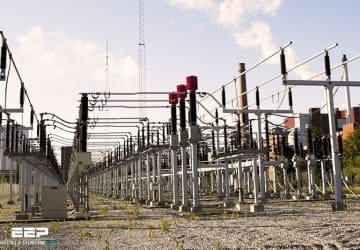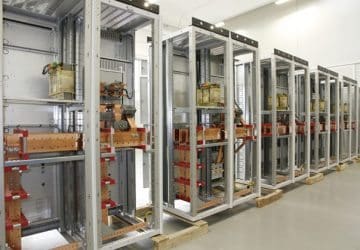Basic Stand-Alone Application of Reclosers
Reclosers are self-contained fault interrupting and reclosing devices, specifically designed for overcurrent protection in secondary distribution systems. Reclosers are situated in selected locations within the overhead distribution network. With the correct protection setting and MV fuse selection coordination, concerning the… Read more
Apr 15, 2015 | By Edvard Csanyi

Configurations and characteristics of distribution substations
Distribution substations come in many sizes and configurations. A small rural substation may have a nominal rating of 5 MVA while an urban station may be over 200 MVA. Figures 1 through 3 show examples of small, medium, and large… Read more
Apr 13, 2015 | By Edvard Csanyi

Back To School – Let’s Calculate Current I3
Referring to the following circuit, calculate direct current I3: Using Kirchhoff’s laws; Using nodal analysis; Applying Thévenin’s theorem at nodes A and B. – KCL stands for Kirchhoff’s Current Law – KVL stands for Kirchhoff’s Voltage Law The following equation… Read more
Apr 10, 2015 | By Edvard Csanyi

Network distribution transformers serving grid and spot networks
Network transformers, the distribution transformers that serve grid and spot networks, are large three-phase units. Network units are normally vault-types or subway types, which are defined as (ANSI C57.12.40-1982): Vault-type transformers // Suitable for occasional submerged operation Subway-type transformers // Suitable for… Read more
Apr 08, 2015 | By Edvard Csanyi

Important primary distribution (radial and loop) system considerations
The primary distribution system is that part of the electric distribution system between the distribution substation and distribution transformers. It is made up of circuits called primary feeders or distribution feeders. These feeders include the primary feeder main or main… Read more
Apr 06, 2015 | By Edvard Csanyi

3 Lighting Essentials You Can’t Deny
Lighting systems in industrial facilities can represent an attractive savings opportunity, especially if lighting systems have not been upgraded or maintained in the past five years. The most cost-effective approach for lighting energy savings is to address the following three issues, in… Read more
Apr 03, 2015 | By Edvard Csanyi

Good voltage regulation and justified power factor correction
Power factor correction and voltage regulation are closely related. In many cases, the desired voltage regulation is costly to obtain. Larger or paralleled conductors to reduce voltage drop under load are, in many cases, the proper solution. However, power factor… Read more
Apr 01, 2015 | By Edvard Csanyi

General guidelines for online partial discharge testing of power cables
Online PD testing is becoming the topic of interest for power cable owners to ensure the safe and continuous operation of power cables. Partial discharge is a localised discharge in the insulation medium due to high voltage stress that does… Read more
Mar 30, 2015 | By Ammar Anwar KHAN

Six energy efficiency improvement opportunities in fan systems
Efficiencies of fan systems vary considerably across impeller types. The average energy saving potential in these systems in the U.S. manufacturing industry is estimated at 6%. For optimal savings and performance, it is recommended that a systems approach is used…. Read more
Mar 27, 2015 | By Edvard Csanyi

Maintenance of transformer load tap changers (LTC)
LTC maintenance is the basis for the regulating transformer’s high level of reliability. The background for maintenance recommendations is as follows: Oil: For LTCs where oil is used for arc-quenching, the arcing at the arcing switch or arcing tap switch… Read more
Mar 25, 2015 | By Edvard Csanyi

Many engineers advocate the use of multiple-transfer switches
Automatic transfer switches are primarily used for emergency and standby power generation systems. These transfer switches may incorporate overcurrent protection and are designed and applied in accordance with the NEC, Articles 230, 517, 700, 701,702 and 710, and other applicable… Read more
Mar 23, 2015 | By Edvard Csanyi

4 Low Voltage Switchboard Partitioning Forms Defined By IEC 61439-2
There are 4 main reasons for partitioning a switchboard. To protect persons against direct contact with dangerous parts. The minimum degree of protection must be IPXXB. To protect the switchboard against the penetration of solid foreign bodies. The minimum degree of protection must be… Read more
Mar 20, 2015 | By Edvard Csanyi

Eleven major causes of power system failures
To gain a broader understanding of power system reliability, it is necessary to understand the root causes of system faults and system failures. A description of major failure modes is provided below. Underground Cable Transformer Failures Lightning Tree Contact Birds… Read more
Mar 18, 2015 | By Edvard Csanyi

6 Transformer Types You Can See In Commercial Installations
Transformers in commercial installations are normally used to change a voltage level from a utility distribution voltage to a voltage that is usable within the building, and are also used to reduce building distribution voltage to a level that can… Read more
Mar 16, 2015 | By Edvard Csanyi

Comparison of motor speed control methods
It is often desirable to control the motor speed, usually for reasons process control for such variables as flow or pressure. Such applications as fans and pumps often have varying output requirements, and control of the motor speed is more… Read more
Mar 13, 2015 | By Edvard Csanyi


